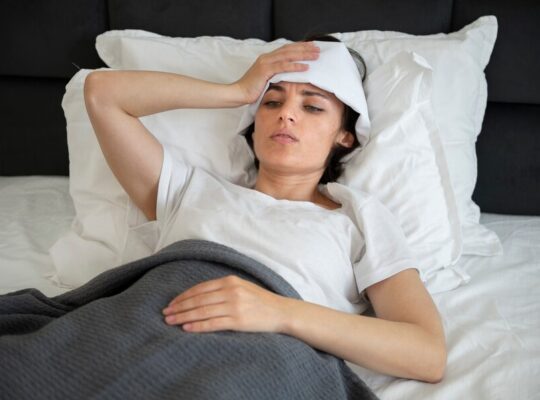Osteoarthritis (OA) is one of the most prevalent joint disorders. It is characterized by the degeneration of cartilage that encapsulates the joints, leading to pain, inflammation, and rigidity. Commonly affected joints include the knees, hips, hands, and spinal joints. Osteoarthritis worsens with age, but it can also occur in young adults due to joint injuries or overuse.
Symptoms of Osteoarthritis
Symptoms vary among individuals, but common signs include:
- Facial swelling, mainly in the cheek area, accompanied by joint pain during or after activity.
- Morning stiffness or stiffness after sitting for some time.
- Pain and swelling over the joint when pressure is applied.
- Muscle stiffness, making it difficult to bend backward or sideways.
- Hard knobby formations (bone outgrowths) near the affected joints.
- Swelling due to inflammation.
Patients often experience morning stiffness that improves after joint mobility. This symptom indicates OA as a disorder affecting daily activities.
Causes of Osteoarthritis
Osteoarthritis is primarily caused by mechanical wear and tear on the joints. When cartilage wears down with age, bones rub against each other, leading to the condition. Other causes include:
- Joint Injuries: Previous trauma can increase the risk of osteoarthritis.
- Repetitive Stress: Occupations or tasks that put pressure on joints can lead to the condition.
- Genetics: It can run in families, making some people more susceptible.
- Obesity: Extra weight puts stress on weight-bearing joints, like the hips and knees.
- Other Diseases: Conditions like rheumatoid arthritis or gout can also cause osteoarthritis.
It’s important to note that osteoarthritis can develop in young adults, especially those with physically demanding jobs.
Managing Osteoarthritis
While there’s no cure for osteoarthritis, management focuses on reducing pain and improving joint mobility. Common management options include:
- Medications: Oral pain relievers like acetaminophen and NSAIDs are often prescribed. In severe cases, stronger medications may be required. Always follow the doctor’s advice regarding medication, as prolonged use can have side effects.
- Physical Therapy: Physical therapists can recommend exercises to strengthen the muscles around the joint, reducing stress and improving mobility. Low-impact activities like walking or swimming are especially beneficial. You can learn more about exercises for joint mobility by reading Exercises for Low Back Pain.
- Weight Management: Losing weight can significantly reduce stress on weight-bearing joints. For more tips on healthy eating, check out our article on Cholesterol Lowering Diet.
- Assistive Devices: Proper footwear, braces, and walking aids can help alleviate pressure on the joints, improving mobility.
- Surgical Options: In severe cases, surgery might be necessary. Procedures like knee or hip replacements are common. Learn more about Total Hip Replacement in our dedicated section.
OA Home Treatments
Several home remedies can help ease osteoarthritis symptoms:
- Heat and Cold Therapy: Heat can help improve joint flexibility, while cold therapy can reduce inflammation and numb painful areas.
- Epsom Salt Baths: Hot baths with Epsom salt are soothing for aching joints.
- Ginger and Turmeric: These natural anti-inflammatories can reduce osteoarthritis pain. You can consume them as part of your diet or in supplement form. For more natural remedies, read our article on Home Remedies for Gallstones.
Exercises for OA
Exercise is essential for OA patients, as it strengthens muscles around joints and reduces pain. Here are some recommended exercises:
- Strengthening Exercises: Focus on building muscle strength around the joint.
- Range-of-Motion Exercises: Help keep joints flexible and prevent stiffness.
- Aerobic Exercise: Low-impact exercises like cycling, swimming, and walking are excellent for joint health. For more information on building muscle strength, check out Build Biceps & Back.
Preventing Osteoarthritis
You can lower your risk of developing osteoarthritis by adopting healthy habits:
- Stay Active: Regular exercise helps keep joints flexible and reduces stiffness.
- Maintain a Healthy Weight: Reducing weight minimizes the stress on your joints.
- Avoid Joint Injuries: Protect your joints during physical activities and avoid overexertion. For more insights into the benefits of physical activity, read our article on Morning Walk Benefits.
Osteoarthritis and Its Mental Effects
Living with chronic pain can take a toll on mental health. People with osteoarthritis often experience frustration, stress, and even depression. Joining a support group or talking to loved ones can help. Learn more about self-care for mental health in our article on Bipolar Disorder Treatment.
FAQ
- What is osteoarthritis?
It is a disease that affects the joints by wearing down cartilage and subchondral bone. - To what extent is exercise beneficial for osteoarthritis?
Yes, exercise strengthens muscles around joints, making movement easier. - What causes osteoarthritis?
Factors include wear and tear, injuries, obesity, and heredity. - Can osteoarthritis be treated?
There is no cure, but symptoms can be managed through medications, physical therapy, and weight management. - Can diet affect osteoarthritis?
Yes, a healthy diet and weight management can help control symptoms. Learn more about healthy eating in our article on Cholesterol Lowering Diet. - What makes osteoarthritis different from rheumatoid arthritis?
It is caused by mechanical stress, while rheumatoid arthritis is an autoimmune disease. - Can young people develop osteoarthritis?
Yes, it can occur in younger individuals, especially those with prior joint injuries or overuse. - How is osteoarthritis treated?
Treatment includes medications, physical therapy, weight management, and, in some cases, surgery. - What preventive measures can help reduce the risk of osteoarthritis?
Staying active and maintaining a healthy weight are key preventive measures. For more tips, check out Morning Walk Benefits. - Does osteoarthritis affect mental health?
Chronic pain can lead to mental health challenges. Learn more in our article on Obsessive Compulsive Disorder.












